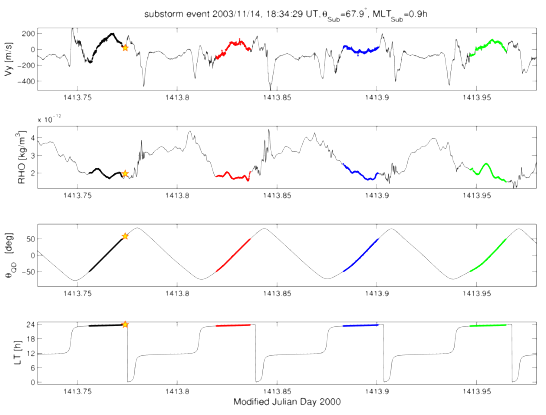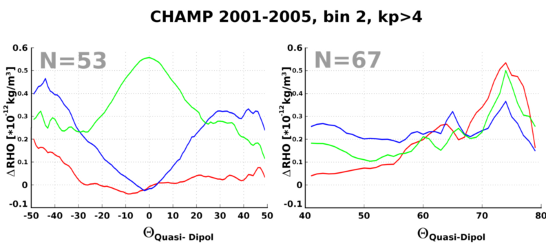Substorm-related thermospheric air density and wind disturbances
Diese Seite ist leider nur in englischer Sprache verfügbar!
The input of energy and momentum from the magnetosphere is most efficiently coupled into the high latitude ionosphere-thermosphere. This study investigates substorm- related observations of the thermosphere derived from the CHAMP satellite. With its sensitive accelerometer the satellite can measure the air density and zonal winds (Doornbos et al., 2009). Based on a large number of substorm events (Frey and Mende, 2006) the average high and low latitude thermospheric response to substorm onsets was deduced. During substorms the thermospheric density is enhanced first at high latitudes. Then the disturbance travels at an average speed of 650 m/s to lower latitudes, and 3-4 hours later the bulge reaches the equator on the nightside. Under the influence of the Coriolis force the traveling atmospheric disturbance (TAD) is deflected westward. In accordance with present-day atmospheric models the disturbance zonal wind velocities during substorms are close to zero near the equator before 24h, and attain moderate westward velocities after midnight. In general the wind system is only weakly perturbed by substorms.

Thermospheric density and wind variations after substorm onsets (marked by the asterisk) can be observed and traced for several subsequent orbits. In our study superposed epoch analysis was used as a tool to obtain mean mass density and wind velocity profiles at the northern polar region and at mid/low latitudes in the nighttime MLT sector after substorm onsets. For this purpose orbit sections of the mid/low latitude and high latitude profiles from the passes before (black), first (red), second (blue), and third (green) pass after onsets were stacked and temporal and spatial variations of density and winds were studied.

In the local time sector around midnight we observe the clearest signal. The density peaks occur first at 74° Mlat, ~10° pole-ward of the average onset latitude. This implies that the main part of the energy is dumped after the poleward leap of the aurora in this midnight sector. The density enhancement can then be traced moving to mid and low latitudes, until it reaches the equator during the third pass after onset (approximately after 3-4 hours).
During magnetically active periods (Kp>4) the following substorm-related features were identified:
- Mass density enhancements by about 15% occur first at auroral latitudes.
- The density bulge then propagates as a Travelling Atmospheric Disturbance (TAD) equatorward.
- This movement is accompanied by converging winds in the polar region.
- ~3.5 hours after onset the bulges from the northern and southern hemispheres meet and pile up at the equator.
- From this the mean velocity of this TAD can be estimated at ~650 m/s.
- The effect of the Coriolis force is not large enough to support the westward displacement of the bulge at the equator.
- An additional westward velocity of the order of 150 m/s is required to explain the satellite measurements.
The results obtained here are regarded a suitable benchmark for testing ionospheric-thermospheric dynamics models during magnetically active periods.
Full story in Ritter & Lühr (2010), 10.5194/angeo-28-1207-2010 | PDF |
References
- Doornbos, E., Förster, M., Fritsche, B., van Helleputte, T., van den IJssel, J., Koppenwallner, G., Lühr, H., Rees, D., Visser, P., and Kern, M. (2009): Air density models derived from multi-satellite drag observations final report, ESTEC contract 21022/07/NL/HE, Technical Report, TU Delft.
- Frey, H.U. and Mende,S. B. (2006): Substorm onsets as observed by IMAGE-FUV, Int. Conf. Substorms, 8.
- Ritter, P. and Lühr, H. (2010): Substorm-related thermospheric density and wind disturbances derived from CHAMP observations, Ann. Geophys. 28, 1207-1220.
